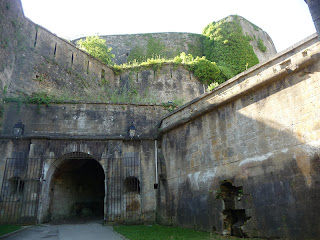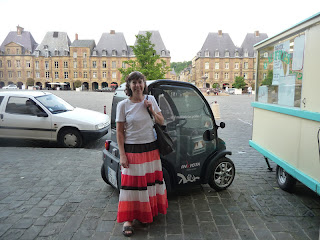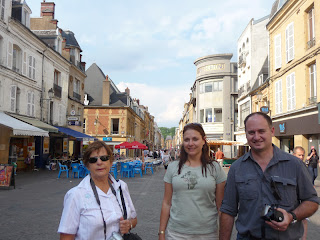We've done two trips to the Ardenne when having our visitors during May/June. First via Sedan towards the Ardenne region of Belgium (Bouillon and Rochehaut which I have already covered in a post during last year) and then returning via Charleville-Mézières.
On the way to Sedan you pass the Woinic, the biggest wild pig in the world and an important symbol of the Ardenne where you will find saucisson made from wild pig on a regular basis (very good!).
The Woinic, along the highway and difficult to miss, is almost 10 m high, 14 m long and 5 m wide and weighs 50 t! The sculptor Eric Sléziak designed and created the Woinic, starting on 1 January 1983 and 120 000 hours of work and 11 years later, completed his task on 11 December 1993.
The Woinic started its 55 km journey from the sculptor's workshop in Bogny-sur-Meuse on 4 August 2008 and reached its destination on 8 August 2008, written 08-08-08, the day of the century for the Ardenne people. I need to explain. In France each department has a number. That number is used in numerous documentation, the postal code (the first 2 nrs in a postal code in France indicates which department the village is in), the car registration, etc. And the number for the Ardenne is 08!
From there it wasn't far to Sedan with the largest fortified medieval castle in Europe, covering 35 000 m2 with its 7 storeys (and its walls thicker than 7 m!). Sedan has observed much in history. During the religious wars in France the Protestants were welcomed in Sedan where they contributed to its wealth. Napolean III was captured in Sedan in 1870 in the Franco-Prussion war, the Germans occupied the castle for four years during WWI. From Jan 1917 - Nov 1918 the castle was a place of extermination where thousands of civil French and Belgiums were condemned to hard labour, where they have met their death, for their acts of resistance. 180 000 people were send to camps in Germany and in the invaded Sedan 30 000 were killed as a result of 8 000 bombs. And during WWII, the Germans first invaded Belgium from where they crossed the Meuse River and won the Second Battle of Sedan (12-15 May 1940). By doing so they have not only bypassed the French fortification system, the Maginot Line, but it also enable them to entrap the Allied Forces that were advancing east into Belgium.
Each year during May Sedan hosts a medieval fête during which period (a weekend) the area around the château is fenced off and once inside, you can explore the numerous stands, shows, walk through people dressed in old fashioned clothes, visit little 'camps' where you can buy something to drink or eat. For my mom, who had been there last year, it was quite a contrast to visit it this year again, but not during the fête. From a complete buzz and squeezing your way through crowds, to silence, not much life around the castle.
Inside the courtyard of the castle where you'll find a hotel and a restaurant
From Sedan it was on towards Belgium to visit Bouillon's castle and have lunch at Rochehaut, where the weather started to change.
I'm not a beer drinker, but if there's one beer I do drink, it's the one of Rochehaut. So my friends had to taste it as well!
With the weather changing and having to be at the station in the evening to fetch JL, we've decided to return to France and visit Charleville-Mézières on the way back. In 1966 the communities of Charleville and Mézières, with smaller communities in the vicinity, were all joined into one town.
The Romans built a road from Reims to Cologne, building a city in the bend of the Meuse river. This city was destroyed by fire in the 10th-c, at which stage Mézières already existed not far from there. In Mézières the church of the Notre-Dame was constructed from 1499-1601 and it was here that king Charles IX got married to Elisabeth of Austria in 1571.
In 1521 the cavalier Bayard defended Mézières against the imperial troops of Charles of Habsburg. This battle had an important consequence for the development of the town, as its importance in the royal defence was acknowledged and it became a town enclosed by an important defense system. Sadly Mézières was heavily bombarded during the last two days of WWI and 50% of the town was destroyed.
In 1606 Charles de Gonzague decided to construct Charleville. (He was a French-Italien and duke of Rethel, also in the Ardenne, as well as Mantua in Italy, another place worth a visit.) The site was chosen at a bend of the Meuse, on the site of the old Roman city. One of the aims while constructing the new town was to rival Sedan, which became a Protestant stronghold. Architect Clément II Métezeau, brother of the architect who designed Place des Vosges in Paris, was instructed to design Charleville's la Place Ducale, which reminds one of Place des Vosges.
Having coffee on the square
The ideal car to drive in France...
The statue of Charles de Gonzague
Wandering the pedestrian area of the town
Charleville-Mézières is also know for its international puppet show and Arthur Rimbaud, French poet who was born in Charleville in 1854. The Rimbaud museum is hosted in an old mill. To my surprise I got to know more about this child genius who wrote his first poems at the age of 15 and became a traveller and explorer (and suspicious dealer) in Africa in a book I am currently reading: Dark Star Safari by Paul Theroux (good book to read). The book covers his travel from Cairo to Cape Town and in the walled city of Harar he writes about Rimbaud who lived there, not wanting people to know who he was or where he comes from. Until a French explorer saw his name and told his boss who Arthur Rimbaud is. Now I'll have to go back to visit the museum!
Above & below: the museum in the old mill
Above: houseboats along the Meuse
Below: a park bordering the river and the museum






























No comments:
Post a Comment